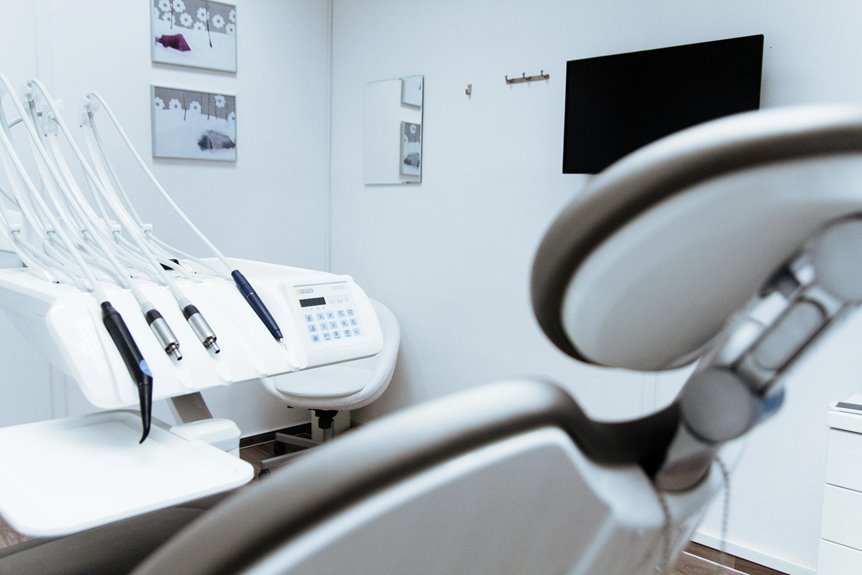It's a coincidence that many dental office owners overlook simple strategies to lower property levies, yet those strategies can greatly impact your bottom line. By understanding and applying the right techniques, you can effectively reduce costs without sacrificing quality or service. From negotiating lease terms to implementing advanced tax planning, there are several avenues you can explore. Curious about how you can streamline your expenses and enhance your practice's financial health? Let's examine these strategies that could change the way you manage your office costs.
Key Takeaways
- Negotiate lease terms to include rent abatement or concessions, reducing initial costs and ongoing expenses.
- Conduct a thorough market analysis to identify competitive rental rates and leverage them during negotiations.
- Optimize your practice structure to maximize tax deductions and minimize property tax obligations.
- Regularly review local property tax assessments and challenge any discrepancies to ensure fair valuations.
- Collaborate with a real estate attorney to identify potential lease clauses that can lower overall property levies.
Gather Lease Documentation
Gathering lease documentation is an important step in securing a dental office property. You need to start by obtaining the proposed lease agreement, which outlines vital terms and conditions. Next, collect letters of intent from landlords to compare your options effectively. Don't forget to gather financial projections, as they'll help you assess whether the lease is feasible for your practice. It's also wise to include a market analysis report to understand the local real estate landscape. Finally, confirm all documents undergo a legal review by a real estate attorney to catch any potential issues. Additionally, be sure to evaluate the lease duration to ensure it aligns with your long-term practice goals.
Identify Practice Goals
Once you've secured your lease documentation, it's essential to pinpoint your practice goals. Start by defining your financial objectives, focusing on reducing overhead costs and increasing cash flow.
You'll want to enhance tax efficiency and protect your assets from financial risk. Long-term sustainability planning is crucial; ensuring your practice remains stable over an extended period is essential.
Next, assess your current financial status. Track key performance indicators, analyze historical data, and identify wasteful expenses. Additionally, consider the impact of cost segregation studies on your tax liabilities, as they can significantly expedite depreciation and enhance tax efficiency.
Set realistic targets for reducing overhead and increasing income. Determine ideal overhead percentages by comparing them to industry benchmarks.
Finally, develop strategic plans to negotiate lease terms, implement cost-segregation studies, and invest in technology. These steps will set you up for financial success and stability.
Conduct Market Research

How well do you know the market where your dental practice operates? Conducting thorough market research is crucial.
Start with a demographic analysis, examining population growth, income levels, and age distribution to gauge demand for your services. Understanding annual production can help you predict how changes in the local population may impact patient flow and revenue generation.
Next, perform a competitor analysis to identify existing practices, their market share, and pricing strategies. Understanding these elements helps you position your practice effectively.
Additionally, assess local market trends and economic indicators, such as employment rates and consumer spending, to guarantee you're aware of potential patient growth.
Develop Negotiation Strategy
Understanding your market gives you a solid foundation for developing a negotiation strategy that can greatly impact your dental office's financial health.
Start by identifying key lease clauses, like rent escalation and termination rights, to guarantee you have the flexibility needed for future changes.
Leverage lease concessions, such as rent abatement periods and landlord contributions, to improve your cash flow and reduce initial costs.
When negotiating favorable terms, consider options like modified gross net leases and NNN expense caps to maintain financial flexibility.
Prepare thoroughly by gathering documentation, conducting market research, and consulting legal experts. Additionally, engaging legal professionals can help you identify potential risks in your lease agreements.
A well-prepared lease negotiation can lead to substantial savings, allowing you to focus on growing your practice rather than worrying about unexpected expenses.
Implement Tax Planning

Implementing effective tax planning strategies is essential for maximizing your dental practice's financial health, especially as tax laws evolve.
Start by leveraging available tax deductions, such as the QBI deduction, which allows you to deduct up to 20% of your qualified business income. Additionally, consider taking advantage of Section 179 and bonus depreciation to deduct the full purchase price of qualifying equipment right away.
Next, optimize your entity structure. Choosing an S Corporation can offer pass-through taxation, reducing double taxation. S-Corp status allows for reasonable salary payments, with remaining profits taken as distributions, which can further minimize tax burdens.
If you own real estate, creating a separate entity can provide asset protection and additional tax benefits.
Evaluating these strategies guarantees you're not only compliant but also positioned to minimize tax liabilities effectively, enhancing your practice's profitability.
Manage Overhead Costs
Managing overhead costs is essential for maintaining the financial health of your dental practice, especially as expenses can quickly spiral out of control.
Start with overhead tracking by identifying your key performance indicators (KPIs). This helps in comparing your costs against industry benchmarks, giving you a clear picture of where you stand.
Regular expense analysis allows you to spot trends and areas of excess spending. Aim for ideal percentages, like keeping salaries at 20% to 24% and lab costs between 8% to 10%. Average dental practice overhead ranges from 55% to 65%, making it crucial to monitor these figures closely.
By prioritizing excess expenses and optimizing staffing, you'll make informed decisions that boost profitability.
Communicate your new plan to your team for better efficiency, ensuring everyone understands their role in managing costs effectively.
Utilize Advanced Tax Strategies

Advanced tax strategies can greatly enhance your dental practice's bottom line. Start by maximizing the Qualified Business Income (QBI) deduction. If your practice is structured correctly, this deduction can markedly lower your taxable income. Be mindful of the income limits to fully benefit from it. Moreover, consider that the pass-thru deduction is applicable to various business structures, allowing for significant tax savings.
Additionally, consider the HSA benefits; contributions are tax-deductible, grow tax-free, and provide tax-free withdrawals for medical expenses. This not only reduces your tax burden but also serves as a valuable employee perk, boosting morale and retention.
Finally, think about strategic investments in equipment or technology that qualify as deductible expenses. By implementing these advanced strategies, you'll effectively lower your property levies while enhancing your practice's financial health.
Frequently Asked Questions
How Can I Negotiate Lower Property Taxes for My Dental Office?
To negotiate lower property taxes for your dental office, review your tax assessment carefully. Use effective negotiation tactics, like presenting comparable property values and highlighting exemptions, to build a strong case for a reduced assessment.
What Are Common Tax Deductions for Dental Practices?
Envision a treasure chest waiting to be accessed. You can claim tax write-offs like office expenses, equipment depreciation, and professional dues. These deductible expenses lighten your financial load, helping your dental practice thrive effortlessly.
How Does Location Affect Dental Office Property Levies?
Location greatly impacts your dental office's property value. As the local economy thrives, property values rise, leading to higher levies. High population density and accessibility can increase demand, affecting your overall operational costs.
Are There Grants Available for Dental Office Property Expenses?
Yes, there are grants available for dental office property expenses. You should explore various funding opportunities, as eligibility often depends on business size, location, and community impact, which can help reduce your overall costs effectively.
What Impact Do Renovations Have on Property Taxes?
Renovations can greatly affect your property taxes. Major renovation costs often trigger tax assessments, potentially increasing your bill. It's essential to understand which projects might lead to a reassessment and how to manage those changes.
Conclusion
By implementing these seven strategies, you can considerably lower your dental office property levies and improve your practice's financial health. Envision negotiating a rent reduction just as a competitive offer lands in your inbox—talk about perfect timing! With thorough market research, smart tax planning, and effective negotiation tactics, you'll not only alleviate immediate financial pressures but also position your practice for long-term success. Take charge of your lease and watch your practice thrive!


